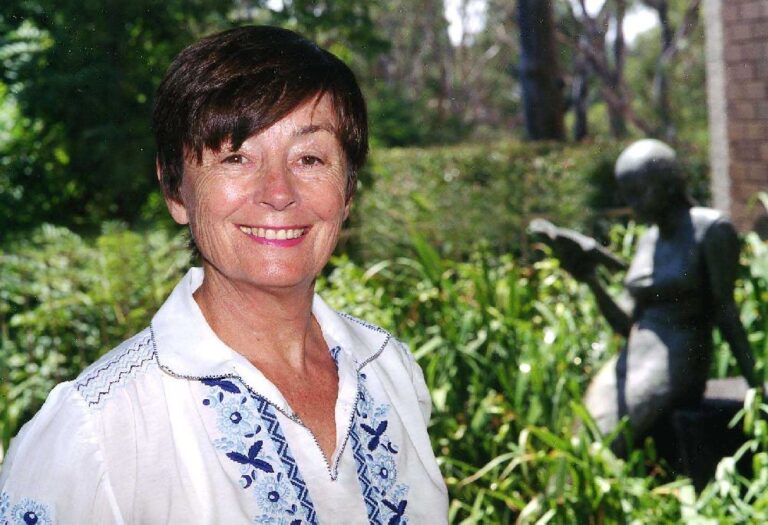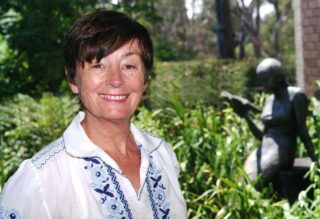- Entry type: Person
- Entry ID: AWE4871
Radford, Gail Gordon
- AM
- Wilenski, Gail Gordon

- Born 30 April 1941, Melbourne, Victoria, Australia
- Occupation Equal Employment Opportunity Officer, Feminist lobbyist, Public servant, Researcher, Veterinarian
Summary
Gail Radford’s first career was in veterinary science. In 1970 she joined Canberra Women’s Liberation and was the first Convenor of WEL-ACT. In 1973 she was appointed to the first National Committee on Discrimination in Employment and Occupation.
In 1975, she was appointed to the Office of the Public Service Board in Canberra as the Director of the Equal Employment Opportunity Section. For fifteen years Gail shaped and led EEO policies and programs, firstly from the Public Service Board and later from the Public Service Commission.
In 1992, Gail was appointed to the position of Chief of the Human Resources Development Division in the headquarters of UNESCO in Paris. At the conclusion of her contract, she returned to Australia in 1994 to become a Member of the Immigration Review Tribunal in Sydney. In 2001 she returned to Canberra to research and write at the Australian National University on the history of WEL and EEO.
In 1985, Gail became a Member of the Order of Australia for her services to women’s affairs and EEO.
Details
Born in Melbourne on 30 April 1941, Gail was the only child of Phyllis Royal Radford (née Bickford), a high school teacher, and John (Jack) Gordon Radford, a journalist and, after the war, an intelligence officer. While Jack was away at the war, Gail and Phyllis lived with Phyllis’s mother Alice Hannah Bickford née Baggs. Gail’s mother, grandmother and aunt, Dame Ada May Norris, were all strong women and feminists. Under their guidance Gail became an independently minded feminist. Dame Ada, with her work on the status of women, people with disabilities and immigrants, was to be a mentor for Gail when she commenced similar work in later life.
Gail attended Fintona Girls’ School in Balwyn. She started studying for a science degree at the University of Melbourne but transferred to second year veterinary science at the University of Sydney in 1961. Here Gail lived in Women’s College, joined in student politics as a keen debater and was a Director of the Board of the Women’s Union. Her particular interest was in providing support for women who, like her, were studying courses where women were under-represented and not fully accepted.
She graduated as a Bachelor of Veterinary Science in January 1966, completed an internship in cardiovascular research at the Animal Medical Center in New York City in 1967 and graduated from Ottawa University in 1971, as a Master of Science in Cardiovascular Physiology.
Gail’s career as a veterinarian included periods of small animal practice in Australia and overseas, manufacturing Swine Fever Vaccine with a United States aid team in Saigon during the height of the Vietnam War and teaching small animal surgery at Sydney University. In Canberra she worked in a small animal practice in the Woden Valley and carried out research for a doctorate on the physiology of social stress in wild rats in the Zoology Department at the Australian National University.
On her return from Canada in 1970, she joined the newly formed Canberra Women’s Liberation and, as a member of its action workshop, organised the first meeting of the Women’s Electoral Lobby (WEL) in Canberra in May 1972. She was the first Convenor of WEL-ACT and combined lobbying for reforms for women with her veterinary career for the next few years.
In May 1973, she was appointed to the first National Committee on Discrimination in Employment and Occupation, as the member with special expertise on the employment of women, and continued to serve on this Committee until she was appointed to the Australian Public Service (APS).
In October 1975, she was appointed to the Office of the Public Service Board in Canberra as the Director of the Equal Employment Opportunity Section. This was the first position of its kind in Australia. Gail was, in essence, the first EEO Officer in Australia. She was given responsibility for the formulation and implementation of EEO policies for women, migrants, Aboriginals and the handicapped, and the avoidance of discrimination in APS employment.
Gail worked in the Public Service Board in Canberra until its abolition in 1987, being promoted to the Senior Executive Service in 1978 and receiving further promotions in 1983 and 1984. In 1987, she was appointed to a senior position in the newly created Public Service Commission.
For fifteen years Gail shaped and led EEO policies and programs, firstly from the Public Service Board and later from the Public Service Commission. She developed policies for the Commonwealth’s 300,000 employees and influenced the direction of priorities in State Government and private sector employment. Under her guidance the approach to providing employment opportunities in the work place, for women and members of minority groups, developed from a series of ad hoc anti-discrimination initiatives to a systematic one, with the provision of properly structured EEO programs supported by legislation.
Gail sat on numerous interdepartmental committees and chaired two subcommittees of the Joint Council, the peak body that carried out negotiations with staff associations in the APS. She chaired the Joint Council Subcommittee on Women and Joint Council Subcommittee on EEO (Minority Groups) and it was in these subcommittees that she negotiated agreement on all EEO initiatives. She was also a member of the National Labour Consultative Council’s Committee on Women’s Employment. In 1980, this Committee released Guidelines for Employers on EEO for Women, which were to pave the way for acceptance of EEO legislation in the private sector.
In 1985, Gail became a Member of the Order of Australia for her services to women’s affairs and Equal Employment Opportunity.
In 1992, Gail was appointed to the position of Chief of the Human Resources Development Division in the headquarters of the United Nations Organisation for Education, Science and Culture (UNESCO) in Paris. This position had been especially created for her to assist UNESCO implement reforms in its human resource management systems. At the conclusion of her contract with UNESCO, she returned to Australia in 1994 to become a Member of the Immigration Review Tribunal in Sydney. Following the abolition of the Tribunal in 1999, she resigned from the Australian Public Service.
Gail returned to Canberra in 2001 to research and write at the Australian National University on the history of WEL and EEO. She worked with Professor Marian Sawer on the Australian Research Council funded project on the History of the Women’s Electoral Lobby. Their book Making Women Count: A History of the Women’s Electoral Lobby in Australia was published by UNSW Press in 2008. Papers and research reports written by Gail can be found on the ANU History of WEL website (http://wel.anu.au/).
Archival resources
- National Library of Australia, Manuscript Collection
- National Archives of Australia, National Office, Canberra
- National Library of Australia, Oral History and Folklore Collection
Digital resources
Published resources
-
Resource
- Trove: Radford, Gail Gordon (19410430-), http://nla.gov.au/nla.party-1665911
-
Site Exhibition
- From Lady Denman to Katy Gallagher: A Century of Women's Contributions to Canberra, Australian Women's Archives Project, 2013, http://www.womenaustralia.info/exhib/ldkg
- Book
